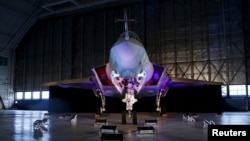With Thursday's renewed pledge by NATO countries to meet defense spending goals, some of the biggest beneficiaries could be U.S. weapons manufacturers, which annually already export billions of dollars worth of arms across the globe.
As the annual NATO summit ended in Brussels, U.S. President Donald Trump claimed success in pushing NATO's 29 member states to meet their 2024 goal of each year spending 2 percent of the size of their national economies on defense, to bolster NATO's readiness in the event of an attack from Russia or anyone else. Currently, only five countries - Britain, Estonia, Greece, Latvia and the U.S. - meet that standard.
While any defense buildup would include an array of costs, such as paying for more troops and construction of military installations, some of the increased spending would likely go toward munitions, fighter jets, missiles and missile defense systems.
The U.S. is already the world's biggest arms exporter, at 34 percent of the global total from 2013 to 2017. The State Department last year approved more than $75 billion in overseas sales of weaponry of one sort or another, topping the previous record of over $68 billion in 2012. Those figures easily surpass weapons sales from the next two biggest arms exporters, Russia and China.
Trade deficit buster?
Some of the biggest weapons and fighter jet makers in the world are U.S. companies - Lockheed Martin, Boeing, Northrop Grumman, Raytheon and General Dynamics, among them. But relatively small shares of their sales have in recent years been to European countries, which now may need to buy more U.S.-made munitions and jets to meet the NATO spending goal.
Increased weapons sales to Europe could also reduce the current $151 billion annual U.S. trade deficit with the European Union, which Trump assails as much as he has complained about lower European national defense expenditures compared to the U.S. in relationship to the size of their respective economies. The U.S. spends 3.5 percent of its economy on defense.
Last year, according to the Security Assistance Monitor, which tracks arms sales trends, five NATO countries — Poland, Canada, Romania, Britain and Greece — were among the 20 largest U.S. arms buyers, with Saudi Arabia, at more than $17 billion, easily topping the list as the biggest U.S. weapons purchaser.
During the 2013-2017 period, the Stockholm International Peace Research Institute reported that Asia and Oceania accounted for 42 percent of global weapons imports, with the Middle East at 32 percent, Europe at 11 percent and Africa and the Americas at about 7 percent apiece.







